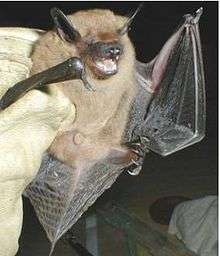Big brown bat
| Big brown bat | |
|---|---|
 | |
| Scientific classification | |
| Kingdom: | Animalia |
| Phylum: | Chordata |
| Class: | Mammalia |
| Order: | Chiroptera |
| Family: | Vespertilionidae |
| Genus: | Eptesicus |
| Species: | E. fuscus |
| Binomial name | |
| Eptesicus fuscus (Palisot de Beauvois, 1796) | |
 | |
| Regional distribution of the big brown bat (gray areas) | |
The big brown bat (Eptesicus fuscus) is native to North America, Central America, the Caribbean, and extreme northern South America.
Description

This medium-sized bat ranges from 10–13 cm (3.9–5.1 in) in body length, with an 28–33 cm (11–13 in) wingspan, and weighs between 14–16 g (0.49–0.56 oz). The fur is moderately long and shiny brown. The wing membranes, ears, feet, and face are dark brown to blackish in color.
Big brown bats are nocturnal, roosting during the day in hollow trees, beneath loose tree bark, in the crevices of rocks, or in man-made structures such as attics, barns, old buildings, eaves, and window shutters. Big brown bats navigate through the night skies by use of echolocation, producing ultrasonic sounds through the mouth or nose. They are known also to produce audible sound during flight, a click or a sound like escaping steam.
Diet
Big brown bats are insectivorous, eating many kinds of night-flying insects including moths, beetles, and wasps which they capture in flight. This causes the sudden, frequent changes in direction.
Hibernation
Big brown bats hibernate during the winter months, often in different locations from their summer roosts. Winter roosts tend to be natural subterranean locations such as caves and underground mines where temperatures remain stable; where a large majority of these bats spend the winter is still unknown. If the weather warms enough, they may awaken to seek water, and even breed.
.jpg)
Lifecycle
Big brown bats mate sporadically from November through March. After the breeding season, pregnant females separate themselves into maternity colonies. In the eastern United States, twins are commonly born sometime in June; in western North America, females give birth to only one pup each year.[2]
Subspecies
The subspecies E. f. fuscus occurs in the entire eastern half of the U.S. except Florida. The subspecies E. f. pallidus occurs in Utah.
See also
References
- ↑ Miller, B.; Reid, F.; Arroyo-Cabrales, J.; Cuarón, A.D. & de Grammont, P.C. (2008). "Eptesicus fuscus". IUCN Red List of Threatened Species. Version 2009.2. International Union for Conservation of Nature. Retrieved 7 February 2010.
- ↑ Best, Troy L.; Altenbach, J. Scott; Harvey, Michael J.; Currie, R. R.; Sutton, K.sourced from the Bats of the Eastern United States poster. Retrieved on 02 April 2014
- Reader's Digest North American Wildlife Mammals, Reptiles and Amphibians (2nd ed.). Reader's Digest. ISBN 0-7621-0035-4.
External links
| Wikimedia Commons has media related to Eptesicus fuscus. |
| Bat Chirp | |
|
|
- Eptesicus fuscus Echolocation Lab at Brown University
- NewScientist.com Article from issue 2581 of New Scientist magazine, 6 December 2006, page 21- Claims bats can navigate by sensing Earth's magnetic field
- Identifying Big Brown Bats by Professional Humane Bat Removers in New England
- Video of Big Brown Bat from Boulder, CO
